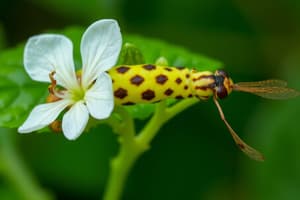Podcast
Questions and Answers
What is the development of the binomial system?
What is the development of the binomial system?
- A method for classifying species
- A universal naming system for species (correct)
- A hierarchy of taxa
- None of the above
What is a genus?
What is a genus?
A group of species that share certain characteristics
What does the binomial system consist of?
What does the binomial system consist of?
Two words: the first is the genus name and the second is the species name.
The genus name begins with a lower-case letter.
The genus name begins with a lower-case letter.
What is taxonomy?
What is taxonomy?
What are taxa?
What are taxa?
What is meant by 'hierarchy of taxa'?
What is meant by 'hierarchy of taxa'?
Which of the following lists the three domains of life?
Which of the following lists the three domains of life?
What are the principal taxa for classifying eukaryotes?
What are the principal taxa for classifying eukaryotes?
Name the four kingdoms of eukaryotes.
Name the four kingdoms of eukaryotes.
Classify the Date Palm from domain to species level.
Classify the Date Palm from domain to species level.
Classify the Grey Wolf from domain to species level.
Classify the Grey Wolf from domain to species level.
What are some reasons for using a natural classification system?
What are some reasons for using a natural classification system?
What are advantages of natural classification?
What are advantages of natural classification?
What are dichotomous keys used for?
What are dichotomous keys used for?
What are the four main plant phyla?
What are the four main plant phyla?
What are the six phyla of animals?
What are the six phyla of animals?
What are the five largest classes of chordates?
What are the five largest classes of chordates?
Flashcards are hidden until you start studying
Study Notes
Development of the Binomial System
- Universal naming system for species established through international congresses.
- Each species name consists of a genus name followed by a specific name.
Genus
- A classification grouping that includes species with shared characteristics.
Binomial Nomenclature
- Composed of two parts: the genus name (capitalized) and the species name (lowercase).
- Names are italicized in printed text; abbreviated after the first use (e.g., L.borealis).
Rules of Binomial Nomenclature
- Genus name starts with an uppercase letter, species with a lowercase letter.
- The earliest named species (post-1753 for plants, post-1758 for animals) is considered the correct name.
Taxonomy
- The scientific practice of classifying living organisms.
Taxa
- Categories or groups used for classification.
Hierarchy of Taxa
- Taxa organized in a hierarchical structure: families → orders → classes → kingdoms/domains.
- As one moves up the hierarchy, groups encompass larger numbers of species with fewer shared traits.
Three Domains of Life
- All organisms fit into three domains: Eubacteria, Archaea, and Eukaryota.
- Terms for members: bacteria, archaeans, eukaryotes.
Principal Taxa for Eukaryotes
- Classification levels include: Kingdom, Phylum, Class, Order, Family, Genus, Species.
Four Kingdoms of Eukaryotes
- Include Animals, Plants, Fungi, and Protoctista, with Protoctista remaining controversial due to its diversity.
Example Classification: Date Palm
- Domain: Eukaryota
- Kingdom: Plantae
- Phylum: Angiospermophyta
- Class: Monocotyledoneae
- Order: Palmales
- Family: Arecaceae
- Genus: Phoenix
- Species: dactylifera
Example Classification: Grey Wolf
- Domain: Eukaryota
- Kingdom: Animalia
- Phylum: Chordata
- Class: Mammalia
- Order: Carnivora
- Family: Canidae
- Genus: Canis
- Species: lupus
Natural vs. Artificial Classification
- Natural Classification groups organisms based on shared ancestry and evolutionary links.
- Artificial Classification relies on arbitrary characteristics, such as grouping animals that can fly.
Reasons for Natural Classification
- Provides a deeper understanding of the biosphere.
- Illustrates evolutionary relationships and predicts shared traits.
Reviewing Classification
- New evidence can lead to the reclassification of groups, splitting or uniting taxa based on common ancestry.
Advantages of Natural Classification
- Facilitates easier species identification and classification.
- Members share characteristics due to common ancestry, aiding in predictions about traits.
Dichotomous Keys
- Tools used for identifying species based on a series of choices.
Main Plant Phyla
- Bryophyta: Includes mosses and liverworts.
- Filicinophyta: Comprises ferns.
- Coniferophyta: Encompasses conifers.
- Angiospermophyta: Includes flowering plants.
Six Animal Phyla
- Porifera: Sponges.
- Cnidaria: Includes hydras, jellyfish, corals.
- Platyhelminthes: Flatworms and their relatives.
- Mollusca: Snails, octopuses, and bivalves.
- Annelida: Segmented worms.
- Arthropoda: Insects, arachnids, crustaceans.
Largest Classes of Chordates
- Bony ray-finned fish.
- Amphibians.
- Reptiles.
- Birds.
- Mammals.
Studying That Suits You
Use AI to generate personalized quizzes and flashcards to suit your learning preferences.




